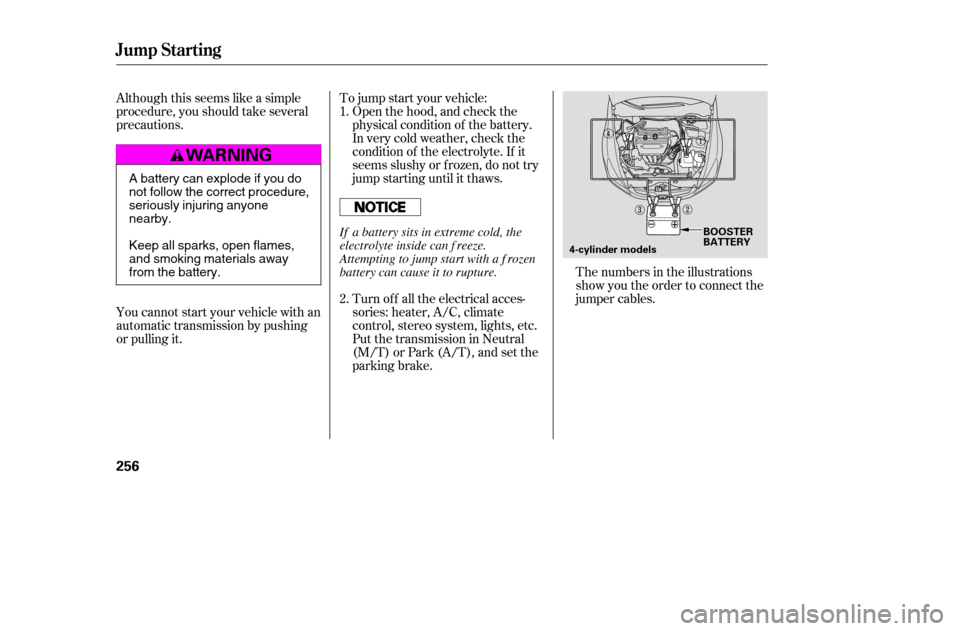Page 246 of 289

If the headlights dim noticeably or
go out when you try to start the
engine, either the battery is
discharged or the connections are
corroded. Check the condition of the
battery and terminal connections
(see page ). You can then try
jump starting the vehicle from a
booster battery (see page ).If youfindnothingwrong,youwill
need a qualif ied technician to f ind
the problem. See
on page .
There may be an electrical
problem, such as no power to the
f uel pump. Check all the f uses
(see page ).
Do you have f uel? Check the f uel
gauge; the low f uel indicator may
not be working.
Are you using a properly coded
key? An improperly coded key will
cause the immobilizer system
indicator in the instrument panel
to blink rapidly (see page ).
In this case, the starter motor’s
speed sounds normal, or even f aster
than normal, when you turn the
ignition switch to START (III), but
the engine does not run.
Are you using the proper starting
procedure? Ref er to on page .
244
256 175 269
264 59
If theEngineWon’tStart
Emergency
Towing
T he Starter Operates Normally
Starting the
Engine
T aking Care of t he Unexpect ed
255
�����—�����—�����y�
�
��
��������y���
�(���%�������y���������y
Page 247 of 289

Although this seems like a simple
procedure, you should take several
precautions.
You cannot start your vehicle with an
automatic transmission by pushing
or pulling it.Open the hood, and check the
physical condition of the battery.
In very cold weather, check the
condition of the electrolyte. If it
seems slushy or f rozen, do not try
jump starting until it thaws.
To jump start your vehicle:
Turn of f all the electrical acces-
sories: heater, A/C, climate
control, stereo system, lights, etc. The numbers in the illustrations
show you the order to connect the
jumper cables.
Put the transmission in Neutral
(M/T) or Park (A/T), and set the
parking brake.
1. 2.
Jump Starting
256
4-cylinder models
BOOSTER
BATTERY
A battery can explode if you do
not follow the correct procedure,
seriously injuring anyonenearby.
Keep all sparks, open flames,
and smoking materials away
from the battery. If a battery sits in extreme cold, the
electrolyte inside can f reeze.
Attempting to jump start with a f rozen
battery can cause it to rupture.
�����—�����—�����y�
�
��
������
�y���
�(���%�������y���������y
Page 248 of 289
�µ
�´
�´
Start the vehicle. If the starter
motor still operates slowly, check
that the jumper cables have good
metal-to-metal contact.
If the booster battery is in another
vehicle, have an assistant start
that vehicle and run it at a fast idle.
Connect the second jumper cable
to the negative ( ) terminal on
the booster battery. Connect the
other end to the grounding strap
as shown. Do not connect this
jumper cable to any other part of
the engine.
Connect one jumper cable to the
positive ( ) terminal on your
battery. Connect the other end to
the positive ( ) terminal on the
booster battery.
6.
5.
4.
3.
CONT INUED
Jump Starting
T aking Care of t he Unexpect ed
257
6-cylinder models
4-cylinder models
6-cylinder models BOOSTER
BATTERY
�����—�����—�����y�
�
��
������
�y���
�(���%�������y���������y
Page 249 of 289

Once your vehicle is running,
disconnect the negative cable f rom
your vehicle, then f rom the
booster battery. Disconnect the
positive cable f rom your vehicle,
then from the booster battery.
Keep the ends of the jumper
cables away from each other and
any metal on the vehicle until
everything is disconnected.
Otherwise, you may cause an
electrical short.If your vehicle overheats, you should
take immediate action. The only
indication may be the temperature
gauge climbing to or above the red
mark. Or you may see steam or
spray coming f rom under the hood.
The pointer of the vehicle’s
temperature gauge should stay in
the midrange. If it climbs to the red
mark, you should determine the
reason (hot day, driving up a steep
hill, etc.).
Saf ely pull to the side of the road.
Put the transmission in Neutral
(M/T) or Park (A/T), and set the
parking brake. Turn of f all
accessories, and turn on the
hazard warning indicators.
If you see steam and/or spray
coming f rom under the hood, turn
of f the engine. Wait until you see
no more signs of steam or spray,
then open the hood.
2.
1.
7.
Jump Starting, If the Engine Overheats
If the Engine Overheats
258
Steam and spray from an
overheated engine can
seriously scald you.
Do not open the hood if steam
is coming out.
Driving with the temperature gauge
pointer at the red mark can cause
serious damage to your engine.
�����—�����—�����y�
�
��
������
�y���
�(���%�������y�������
�y
Page 251 of 289

This indicator should never come on
when the engine is running. If it
starts flashing or stays on, the oil
pressure has dropped very low or
lost pressure. Serious engine
damage is possible and you should
take immediate action.Saf ely pull of f the road, and shut
of f the engine. Turn on the hazard
warning indicators.
Let the vehicle sit f or a minute.
Open the hood, and check the oil
level (see page ). An engine
very low on oil can lose pressure
during cornering and other driving
maneuvers.
If necessary, add oil to bring the
level back to the full mark on the
dipstick (see page ).
Start the engine, and watch the oil
pressure indicator. If it does not go
out within 10 seconds, turn of f the
engine. There is a mechanical
problem that needs to be repaired
bef ore you can continue driving
(see on page
). If the charging system indicator
comes on brightly when the engine
is running, the battery is not being
charged.
Immediately turn of f all electrical
accessories. Try not to use other
electrically operated controls such as
the power windows. Keep the engine
running; starting the engine will
discharge the battery rapidly.
Go to a service station or garage
where you can get technical
assistance.
1. 2. 3. 4.
213
164
269
L ow Oil Pressure
Indicator
Emergency T owing Charging System
Indicator
L ow Oil Pressure Indicator, Charging System Indicator
260
Running the engine with low oil
pressure can cause serious mechanical
damage almost immediately. Turn of f
the engine as soon as you can saf ely get
the vehicle stopped.
�����—�����—�����y�
�
��
����
���y���
�(���%�������y���������y
Page 252 of 289

This indicator may also come on
along with the ‘‘D’’ indicator.
Your vehicle has certain ‘‘readiness
codes’’ that are part of the on-board
diagnostics f or the emissions
systems. In some states, part of the
emissions testing is to make sure
these codes are set. If they are not
set, the test cannot be completed.
If your vehicle battery has been
disconnected or gone dead, these
codes are erased. It takes at least
three days of driving under various
conditions to set the codes again.
If the indicator comes on
while driving, it means one
of the engine’s emissions control
systems may have a problem. Even
though you may f eel no dif f erence in
your vehicle’s perf ormance, it can
reduce your f uel economy and cause
increased emissions. Continued
operation may cause serious damage.
If you have recently ref ueled your
vehicle, the indicator coming on
could be due to a loose or missing
f uel f ill cap. Tighten the cap until it
clicks at least three times.
Tightening the cap will not turn the
indicator of f immediately; it takes at
least three days of normal driving.
If the indicator comes on repeatedly,
even though it may turn of f as you
continue driving, have the vehicle
checked by the dealer as soon as
possible. To check if they are set, turn the
ignition switch to ON (II), without
starting the engine. The malf unction
indicator lamp will come on f or 20
seconds. If it then goes of f , the
readiness codes are set. If it blinks 5
times, the readiness codes are not
set. If possible, do not take your
vehicle f or a state emissions test
until the readiness codes are set.
Refer to
f or more inf ormation (see page ).
284
Malf unct ion Indicat or L amp
Readiness Codes State Emissions T esting
T aking Care of t he Unexpect ed
261
If you keep driving with the
malf unction indicator lamp on, you can
damage your vehicle’s emissions
controls and the engine. Those repairs
may not be covered by your vehicle’s
warranties.
�����—�����—�����y�
�
��
��������y���
�(���%�������y���������y
Page 258 of 289
�µ�µ
�Î �Î �Î
�´
�Î
No. Amps. Circuits Protected No. Amps. Circuits Protected No. Amps. Circuits Protected
CONT INUED
: 6-cylinder models
1 2345
10 A
(30A) 10 A
15 A
10 A Left Headlight Low Beam
(Rear Defroster Coil)
Left Headlight High Beam
Small Light
Right Headlight High Beam 6789
10 10 A
7.5 A 15 A
20 A Right Headlight Low Beam
Back Up
FI ECU
Condenser f an
Not Used 111112131415161717181819202122 23
20 A
30 A
7.5 A
20 A
40 A
40 A
15 A
30 A
30 A
20 A
40 A
40 A
(40 A)
40 A
100 A
50 A
50 A Cooling Fan
Cooling Fan
MG. Clutch
Horn, Stop
Rear Defroster
Back Up, ACC
Hazard
ABS Motor
TCS Motor
ABS F/S
TCS
Option
Option
Heater Motor
Battery
Not Used
BIG1Main
Power Window Main
Fuse Locations
T aking Care of t he Unexpect ed
267
UNDER-HOOD FUSE/RELAY BOX
�����—�����—�����y�
�
�����������y���
�(���%�������y���������y
Page 261 of 289
If you decide to tow your vehicle
with all f our wheels on the ground,
make sure you use a properly-
designed and attached tow bar.
Prepare the vehicle for towing as
described previously, and leave the
ignition switch in the ACCESSORY
(I) position so the steering wheel
does not lock. Make sure the radio
and any items plugged into the
accessory power socket are turned
of f so they do not run down the
battery.
Emergency T owing
270
The steering system can be damaged if
the steering wheel is locked. Leave the
ignition switch in the ACCESSORY (I)
position, and make sure the steering
wheel turns f reely bef ore you begin
towing.
�����—�����—�����y�
�
�����������y���
�(���%�������y���������y